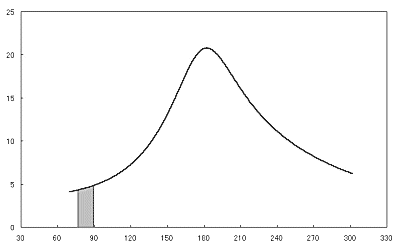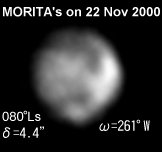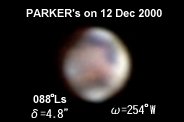2001 report #02
2000 Mars Observation Reports -- #02--
OAA MARS SECTION
Mars Observations
made during the period
from16 Nov 2000 (077°Ls) to 15 Dec 2000 (090°Ls)
based on the article published in CMO #238 (25 December 2000)
by Masatsugu MINAMI, Director of the OAA Mars Section

Mars is rapidly going down to the south, while its position is rather high up now near the meridian when the sun rises. The planet passed just to the north of Spica in mid-December. On 22 Nov (080°Ls) ISHADOH (Id) at Okinawa started his routine observation of Mars. On 9 Dec (087°Ls) HIGA (Hg) at Okinawa first tried to shoot Mars by a Nikon digital camera. On 12 Dec(088°Ls) Don PARKER (DPk) produced series of excellent CCD images while the apparent diameter was 4.8 arcsecs. MORITA (Mo) pointed his telescope to the planet nine mornings (LtE), but among them he just picked out one image taken on 22 Nov (080°Ls) to send to us.
This time we treat the period from 16 November 2000 (077°Ls) to 15 December 2000 (090°Ls).
We hereafter depict every time the period concerned on a graph showing the variation of the angular diameter in 2001 (made by NISHITA (Ns)). The apparent angular diameter went up from 4.3" to 4.8" during the present period. The central latitude was from 25°N to 21°N (will on the northern hemisphere for the present up until the beginning of April 2001). The phase angle was up from 26° to 30° (will attain its maximum at the beginning of March 2001). The planet is now observable from around 4:30 local time.
The following list summarises the work made during the present period:
HIGA, Yasunobu (Hg) Naha, Okinawa, Japan
1 Digital Image (9 December 2000) 25cm F6.7 spec equipped with Nikon CoolPix990
ISHADOH, Hiroshi (Id) Naha, Okinawa, Japan
4 Drawings (22, 26, 30 November; 14 December 2000) 400, 530x 31cm speculum
MINAMI, Masatsugu (Mn) Fukui, Japan
33 Drawings (18, 22~25 November; 1, 2, 4, 7, 8, 15 December 2000)
400, 480, 600x 20cm refractor*
MORITA, Yukio (Mo) Hatsuka-ichi, Hiroshima, Japan
1 CCD Image (22 November 2000) f/50x 25cm spec equipped with an ST-5C
NAKAJIMA, Takashi (Nj) Fukui, Japan
8 Drawings (18, 22, 24, 25 November; 2 December 2000) 400, 480x 20cm refractor*
PARKER, Donald C (DPk) Miami, FL, USA
3 Sets of CCD Images (12 December 2000)
f/55x 41cm speculum equipped with a Lynxx PC
* Fukui City Observatory
Observations:
On 18 Nov (078°Ls) NAKAJIMA (Nj) and Mn at Fukui observed the area around LCM=285°W just detecting the north polar cap (npc) and the darker area at Syrtis Mj under poor seeing condition.
 On 22 Nov (080°Ls) they observed a 30 degree width from LCM=229°W until LCM=258°W (at 22:00 GMT) : The npc was whitish evident surrounded by the broad dark band at Utopia to Gyndes. Notable was that the southern limb (s-limb) to Hellas was very bright. Elysium was light near the terminator. On the day ISHADOH (Id) made his first sketch at LCM=254°W: Syrtis Mj was not so evident under the morning mist, but M Cimmerium was dark detected and Elysium was light near the terminator. The npc was well shown up with a dark broad band. MORITA (Mo) obtained an R image on the same morning at LCM=261°W where Syrtis Mj is quite evident (due to the R light). Hellas and the npc are normally shot, and Utopia and M Tyrrhenum are well described.
On 22 Nov (080°Ls) they observed a 30 degree width from LCM=229°W until LCM=258°W (at 22:00 GMT) : The npc was whitish evident surrounded by the broad dark band at Utopia to Gyndes. Notable was that the southern limb (s-limb) to Hellas was very bright. Elysium was light near the terminator. On the day ISHADOH (Id) made his first sketch at LCM=254°W: Syrtis Mj was not so evident under the morning mist, but M Cimmerium was dark detected and Elysium was light near the terminator. The npc was well shown up with a dark broad band. MORITA (Mo) obtained an R image on the same morning at LCM=261°W where Syrtis Mj is quite evident (due to the R light). Hellas and the npc are normally shot, and Utopia and M Tyrrhenum are well described.
On 23 Nov (080°Ls), the sky was fine at Fukui, and the temperature went down to 5.5°C inside the dome. Mn watched from LCM=217°W to LCM=246°W: The s-limb was bright and adjacent to it the marking was quite dark in the evening. Elysium was whitish light at the preceding terminator. The npc looked normal and such surrounding markings as Utopia were dark evident. The morning mist was thick but Syrtis Mj looked to be coming.
On 24 Nov (080°Ls) the regions from LCM=207°W(Mn) to LCM=232°W(Nj) were observed at Fukui: The npc was whitish definite, and the band of Gyndes was dark. Inside Elysium was not detected. The s-limb light and M Cimmerium dark.
On 25 Nov (081°Ls) the observable regions proceeded to LCM=198°W(Mn) to LCM=222°W(Nj): Similar to the day before, the npc and its neighbourhood were observed. M Cimmerium obvious. A thick mist at the following limb was seen.
On 26 Nov (081°Ls) Id observed at LCM=213°W where the npc was definite and the s-limb was also light. M Cimmerium lay dark. The dark marking around Utopia was evident.
On 30 Nov (083°Ls), Id however saw at LCM=176°W that the s-limb was quite dull. The mist at the following limb was thick. The npc was obvious with the surrounding dark broad band of Gyndes-Utopia. Id observed these days at around 21:30~40 GMT.
On 1 Dec (083°Ls) Mn at Fukui observed at LCM=149°W~168°W where the npc showed a clear boundary, the shadowy area from Propontides to Phlegra was definitely seen and Elysium was light near the following limb. The s-limb looked dull. M Sirenum was caught and at the terminator the area from Tharsis to Olympus Mons appeared whitish bright, reminiscent of the scene that we observed in Feb and Mar 1997 (cf CMO #188 p2045-46).
On 2 Dec (084°Ls) at Fukui, Nj and Mn observed around LCM=135°W: the npc and the Tharsis were quite the same as the day before, but the s-limb looked slightly lighter.
From 4 Dec (085°Ls) to 8 Dec (086°Ls), Mn observed the surfaces where the CM ran from LCM=069°W to LCM=137°W: M Acidalium was darkly seen on the afternoon side and followed by a faintly shadowy large area apart from the equatorial band. The area from Xanthe to Tharsis was whitish light near the evening terminator; these thus suggesting a misty zone along the equatorial band. The dark markings on the southern hemisphere were visible but not well identified. The npc was obvious, and the limb side from the s-limb to the following one appeared whitish light. On the morning of 8 Dec JST (still 7 Dec GMT), the temperature inside the dome went down to 2°C
HIGA's trial images by the use of a digital camera on 9 Dec (at LCM=052°W) suffered from strong dispersion; maybe he need to use a wedge prism if the planet's altitude is low.
 On 12 Dec (088°Ls) Don PARKER (DPk) secured a series of superb three-colour images at LCM=254°W, LCM=258°W and LCM=264°W starting from 10:45 GMT in Florida. Hellas is at its height. Syrtis Mj is already popped out from the following mist (the local time of Syrtis Mj is nearly at noon when LCM=254°W since The phase angle=30°). Elysium is whitish light near the evening terminator followed by the dark patch at Ætheria. DPk considers that the morning mist is relayed by a faint haze at the equatorial band to the evening cloud at Elysium. Near the terminator, M Cimmerium is seen separated by a faint gap of Hesperia. N Alcyonius is not fully isolated though its northern area of Utopia is described well dark. The brighter parts including the np region are shown large, not sharp but blurred; the combination of filters does not seem to produce the shape of the npc (the npc itself is much smaller in the naked eyes). The G and B filters DPk uses are said to block the IR light without any addition.
On 12 Dec (088°Ls) Don PARKER (DPk) secured a series of superb three-colour images at LCM=254°W, LCM=258°W and LCM=264°W starting from 10:45 GMT in Florida. Hellas is at its height. Syrtis Mj is already popped out from the following mist (the local time of Syrtis Mj is nearly at noon when LCM=254°W since The phase angle=30°). Elysium is whitish light near the evening terminator followed by the dark patch at Ætheria. DPk considers that the morning mist is relayed by a faint haze at the equatorial band to the evening cloud at Elysium. Near the terminator, M Cimmerium is seen separated by a faint gap of Hesperia. N Alcyonius is not fully isolated though its northern area of Utopia is described well dark. The brighter parts including the np region are shown large, not sharp but blurred; the combination of filters does not seem to produce the shape of the npc (the npc itself is much smaller in the naked eyes). The G and B filters DPk uses are said to block the IR light without any addition.
On 14 Dec (089°Ls) at LCM=038°W, Id detected M Acidalium standing dark and well shaped near the CM. The npc looked duller and smaller. The limb side from the s-limb to the following limb was light.
On 15 Dec (090°Ls), Mn observed at LCM=358°W and 018°W: The s-limb was not so light, but S Sabæus to S Meridiani were well inside. Chryse was whitish light at the following side. M Acidalium was also seen, and the npc was compact.
It is recommended to observe visually every 40 minutes simply not because 40 minutes produce a difference of ten degrees but mainly because the difference of the rotation periods of Mars and the Earth is just near 40 minutes. Because of this fact the same Martian surface faces to us 40 minutes earlier on the following day. Hence if one continues to observe every 40 minutes at the same Earth times every day, one can obtain several sets of drawings at the same LCM made on different days to compare. For the CCD work, a 40 minute duration looks too long to wait, and hence a 20 minute separation may be recommended as Don PARKER does. If one carries out onefs observations every 20 minutes at the same time every day, one will obtain two sets of data since 40=2x2. This implies as if one person does what two of us (Nj and Mn) do at the Fukui City Observatory every night.
The next issue shall review the observations made during a one-month period from 16 December to 15 January 2001. We hope every CCD image is emailed in a jpeg file with a file name beginning with the observer's name to vzv03210@nifty.ne.jp as well as to cmo@mars.dti.ne.jp the latter being for the CMO Web-Site. Drawings are preferred to be sent in an A4 sized format with just one drawing on one sheet.
With best wishes for a Happy New Year!
Reports will be acknowledged if air-mailed to M MINAMI at Mikuni
(ask the mail-address through vzv03210@nifty.ne.jp ) .
Back to Top Page
 On 22 Nov (080°Ls) they observed a 30 degree width from LCM=229°W until LCM=258°W (at 22:00 GMT) : The npc was whitish evident surrounded by the broad dark band at Utopia to Gyndes. Notable was that the southern limb (s-limb) to Hellas was very bright. Elysium was light near the terminator. On the day ISHADOH (Id) made his first sketch at LCM=254°W: Syrtis Mj was not so evident under the morning mist, but M Cimmerium was dark detected and Elysium was light near the terminator. The npc was well shown up with a dark broad band. MORITA (Mo) obtained an R image on the same morning at LCM=261°W where Syrtis Mj is quite evident (due to the R light). Hellas and the npc are normally shot, and Utopia and M Tyrrhenum are well described.
On 22 Nov (080°Ls) they observed a 30 degree width from LCM=229°W until LCM=258°W (at 22:00 GMT) : The npc was whitish evident surrounded by the broad dark band at Utopia to Gyndes. Notable was that the southern limb (s-limb) to Hellas was very bright. Elysium was light near the terminator. On the day ISHADOH (Id) made his first sketch at LCM=254°W: Syrtis Mj was not so evident under the morning mist, but M Cimmerium was dark detected and Elysium was light near the terminator. The npc was well shown up with a dark broad band. MORITA (Mo) obtained an R image on the same morning at LCM=261°W where Syrtis Mj is quite evident (due to the R light). Hellas and the npc are normally shot, and Utopia and M Tyrrhenum are well described. 
 On 12 Dec (088°Ls) Don PARKER (DPk) secured
On 12 Dec (088°Ls) Don PARKER (DPk) secured